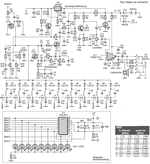neazoi
Advanced Member level 6
Hi,
Although an MCU would easily provide this function, I wonder if there is another way of reading a voltage level, (between 0-8v or so, tiny currents for varicap driving) and store it, then recall it, to output this voltage level to the varicap.
Can you think of any way crazy or not this could be accomplished?
Although an MCU would easily provide this function, I wonder if there is another way of reading a voltage level, (between 0-8v or so, tiny currents for varicap driving) and store it, then recall it, to output this voltage level to the varicap.
Can you think of any way crazy or not this could be accomplished?
